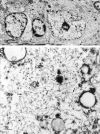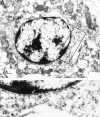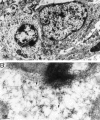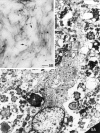Filamentous tau in oligodendrocytes and astrocytes of transgenic mice expressing the human tau isoform with the P301L mutation
- PMID: 12507904
- PMCID: PMC1851123
- DOI: 10.1016/S0002-9440(10)63812-6
Filamentous tau in oligodendrocytes and astrocytes of transgenic mice expressing the human tau isoform with the P301L mutation
Abstract
We recently reported a transgenic mouse line (JNPL3) that expresses mutant (P301L) tau and develops neurofibrillary tangles composed of filamentous tau aggregates. Here we show that these mice have abnormal tau filaments not only in neurons, but also in oligodendrocytes and astrocytes. Similar results were detected in another transgenic line (JNPL2+3+) that expresses the longest human tau isoform with the P301L mutation. The ultrastructure of the tau filaments and immunoreactivity with tau and ubiquitin antibodies were similar in glia and neurons. Given similarities of the lesions in the mice to human neuronal and glial inclusions, these transgenic mice appear to be a valuable model to study pathogenesis of the neurodegenerative tauopathies.
Figures





Similar articles
-
Transgenic mouse model of tauopathies with glial pathology and nervous system degeneration.Neuron. 2002 Aug 1;35(3):433-46. doi: 10.1016/s0896-6273(02)00789-4. Neuron. 2002. PMID: 12165467
-
Endogenous tau aggregates in oligodendrocytes of rTg4510 mice induced by human P301L tau.J Alzheimers Dis. 2014;38(3):589-600. doi: 10.3233/JAD-130986. J Alzheimers Dis. 2014. PMID: 24028867
-
Ultrastructural neuronal pathology in transgenic mice expressing mutant (P301L) human tau.J Neurocytol. 2003 Nov;32(9):1091-105. doi: 10.1023/B:NEUR.0000021904.61387.95. J Neurocytol. 2003. PMID: 15044841
-
Deletion of murine tau gene increases tau aggregation in a human mutant tau transgenic mouse model.Biochem Soc Trans. 2010 Aug;38(4):1001-5. doi: 10.1042/BST0381001. Biochem Soc Trans. 2010. PMID: 20658993 Review.
-
[The microtubule-associated protein tau in neurodegenerative diseases. Tauopathies].Rev Neurol. 2001 Jul 16-31;33(2):169-77. Rev Neurol. 2001. PMID: 11562878 Review. Spanish.
Cited by
-
Rapid neurofibrillary tangle formation after localized gene transfer of mutated tau.Am J Pathol. 2004 Jan;164(1):347-53. doi: 10.1016/S0002-9440(10)63124-0. Am J Pathol. 2004. PMID: 14695347 Free PMC article.
-
A proteomic network approach resolves stage-specific molecular phenotypes in chronic traumatic encephalopathy.Mol Neurodegener. 2021 Jun 25;16(1):40. doi: 10.1186/s13024-021-00462-3. Mol Neurodegener. 2021. PMID: 34172091 Free PMC article.
-
Obesity, diabetes, and leptin resistance promote tau pathology in a mouse model of disease.Neuroscience. 2016 Feb 19;315:162-74. doi: 10.1016/j.neuroscience.2015.12.011. Epub 2015 Dec 14. Neuroscience. 2016. PMID: 26701291 Free PMC article.
-
Knock-out and transgenic mouse models of tauopathies.Neurobiol Aging. 2009 Jan;30(1):1-13. doi: 10.1016/j.neurobiolaging.2007.05.010. Epub 2007 Jun 22. Neurobiol Aging. 2009. PMID: 17590238 Free PMC article. Review.
-
Role for glyoxalase I in Alzheimer's disease.Proc Natl Acad Sci U S A. 2004 May 18;101(20):7687-92. doi: 10.1073/pnas.0402338101. Epub 2004 May 5. Proc Natl Acad Sci U S A. 2004. PMID: 15128939 Free PMC article.
References
-
- Delacourte A, Buée L: Normal and pathological tau proteins as factors for microtubule assembly. Int Rev Cytol 1997, 171:167-224 - PubMed
-
- Papasozomenos SC, Binder LI: Phosphorylation determines two distinct species of tau in the central nervous system. Cell Motil Cytoskeleton 1987, 8:210-226 - PubMed
-
- Shin R-W, Iwaki T, Kitamoto T, Tateishi J: Hydrated autoclave pretreatment enhances tau immunoreactivity in formalin-fixed normal and Alzheimer’s disease brain tissues. Lab Invest 1991, 64:693-702 - PubMed
Publication types
MeSH terms
Substances
Grants and funding
LinkOut - more resources
Full Text Sources
Other Literature Sources
Molecular Biology Databases

